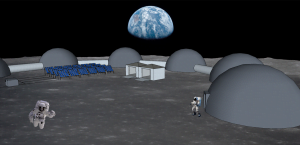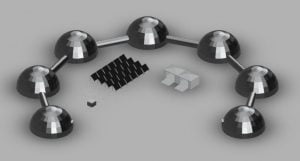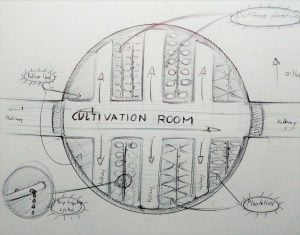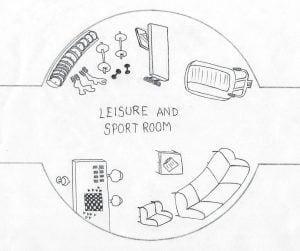Moon Camp Pioneers Gallery 2020-2021
In Moon Camp Pioneers each team’s mission is to 3D design a complete Moon Camp using Fusion 360. They also have to explain how they will use local resources, protect astronauts from the dangerous of space and describe the living and working facilities.
Team: MTM (MANJON TO THE MOON)
IES PADRE MANJÓN GRANADA Spain 17, 16
External viewer for 3d project
|
Project description
Our Moon Camp is designed to meet all the basic needs that will be necessary to cover to keep astronauts alive. It is designed with low-cost materials that are easy to treat, but which in turn are very resistant to changes in temperature and are considerably strong, which provides us with constant and very important security and stability. The camp is divided into different sections in the form of domes connected to each other, in which each of the functions that will be necessary to perform on a daily basis will be developed. All of them are equipped with the tools that will be used in each activity. In addition to all the capsules that make up the camp, there will be a separate location where the solar panels are located, through which energy is obtained for the base. Our camp, in addition to providing security against the environment to which they are subjected, includes a play room and a gym, that also ensures the physical condition of the astronauts through daily exercises in the gym, and mental health, with board games. such as chess or parchis, with which the members of the group can play, to have a fun time together, and maintain their mental health. |
|||
|
Where do you want to build your Moon Camp?
The camp will be located near the lunar poles at the north pole, because it is an interesting area to investigate, which is the most well-known and explored place on the moon, where there are large ice sheets, which would be used to obtain water by defrosting them. There are also craters, one of which would be the camp and where investigations could be conducted. At the Moon’s north pole, sunlight is almost constant, useful as one of the camp’s energy sources using solar panels, which would produce energy and melt ice sheets into liquid water. In the lunar poles the thermal oscillation is less than in the other points of the Moon, this being a thermal amplitude of 50ºC while in other areas it can be up to 200ºC, This makes that in the place where the camp is located the temperature is more favorable than in other regions. How do you plan to build your Moon Camp? Describe the techniques and materials you would use.
In the case of having to determine how we should take the materials to the Moon, it would be through a spacecraft. We thought of materials that were not heavy and resistant. The main composition of the camp is of carbon fibers printed in 3d, so that they constitute a hermetic structure and that in turn protect the astronauts from thermal oscillation. In addition, advanced ceramics, beryllium oxide substrates, aluminum as insulation for electrical circuits, translucent alumina for lamps and fiberglass will be used to make window panes. Construction techniques would be carried out on Earth, so that on the Moon astronauts would have to make the least possible effort. This would be through the use of prefabricated structures and with the simplest methods possible that would allow astronauts to assemble much of the structure on the first day, to devote the rest of the days to primary tasks. Astronauts would have to dig into the moon with some kind of tool like drills. The design of the camp will be through domes interconnected by tunnels that will give a solid structure to the camp. We want everything to be connected so that it is easily accessible and we have a general ventilation system, humidity regulation,… However, each module in the camp shall be separate from the others so that, in the event of one failure, it does not harm the rest. We will also have to build a base that houses the vehicles we use to collect samples, and a large antenna to communicate with Earth. The environment on the Moon is very dangerous for the astronauts. Explain how your Moon Camp will protect them.
The camp will be located in one of the craters of the Moon so that both the structure and the astronauts are protected from dangerous solar radiation, temperature differences and less likely to impact micrometeoroids at the base. To micrometeoroids: the top of the camp will be constructed of carbon fiber to prevent the structure from breaking or deforming. In the face of lunar dust: – Outdoors: wear space suits and clean each time you enter the camp. – At the base: there will be a room where all the lunar dust will be sucked before accessing any other interior space. – Quality of life: there will be temperature and humidity regulators, and plants that provide the necessary oxygen. – Physical health: exercise machines and equipment will be available so that the physical condition of the crew does not deteriorate due to the lack of atmospheric pressure. – Mental health: they will have some board games of their choice such as chess or card games. Explain how your Moon Camp will provide the astronauts with:
|
|||
|
Water
|
Food
|
Electricity
|
Air
|
|
We know that on the Moon there is water at the poles and in their craters. The latter appear to be in some species of glass or grain-shaped lunar bubbles, so obtaining them to water the garden would be quite complicated. However, the water at the poles freezes, meaning that by means of a filtration system and another to make it liquid, they could obtain at least part of the water needed for the survival of the plants. Another utility would be electrolysis: it consists of the decomposition of water to obtain O2 and H2 through an electric current fed by a power source, a battery or battery, connected by electrodes to water. Oxygen would be released into the atmosphere for astronauts, or hydrogen, through another reaction along with carbon dioxide would get water and methane. It is the current system used by NASA astronauts. |
It could be obtained from lunar sand, it would even be possible that a part of the land was contributed from the Earth. Get a ship that contains the necessary resources that are needed to carry out all this process. It would be necessary to make, as on Earth, compost. Therefore, we would resort to fungi, earthworms and decomposing bacteria, as well as actinomycetes, responsible for the decomposition of plant remains. |
As for energy, after considering the possible options and varieties to obtain energy, the most effective would be solar energy. Due to the climatic conditions of the Moon, the days are always sunny and last longer than an Earth day, so that energy could be obtained in abundance. Moreover, we should also take into account that there a few situations when the Moon is without sunlight for hours (eclipses and nights, that are also longer), so we should have a battery that saves enough energy not to leave the camp without power during those moments; and some kind of mechanism that indicates the direction of the Sun at all times (sunflowers). In addition, to ensure maximum daylight hours, the solar panel field should be located in an area where daylight hours last longer (for example, on the edge of a crater called Shackleton, at the south pole), to obtain the greatest amount of energy possible. |
When it comes to obtaining oxygen to breathe in our camp, we will distinguish different ways of doing it. The most viable will be through the production of oxygen produced by some plants and algae, which are not very difficult to maintain, since we only need enough water and light to keep them alive, and these would easily provide a sufficient amount of oxygen, and they will also serve as food, which would be to kill two birds with one stone. |
|
Explain what would be the main purpose of your Moon Camp (for example: commercial, scientific, and/or tourist purposes).
The main purpose of our Moon Camp will be the investigation of new materials and processes that take place on the Moon. For this reason, our camp has a laboratory in one of the domes of the base, in which samples of the materials that the astronauts collect from the moon will be analyzed, in order to investigate their composition and qualities; with the ultimate goal of finding better alternatives to existing materials on Earth, and replacing them with new ones. |
|||
|
Describe a day on the Moon for your Moon Camp astronaut crew.
A day on the moon will consist of a routine in which the astronauts will wake up, have breakfast together and will have a small meeting afterwards in which they will agree on the work of each couple assigned for that day. A couple will be responsible for making food and writing down the investigations of what happened the previous day, as well as doing daily life inside the camp. They will carry out water harvesting, take care of the garden, clean the camp, etc. The other couple will go outside to investigate. They will agree on an hour to return to the camp. This way, every two days (the days they do not go out) they will recount what happened. The couples will be rotating and one day one couple will go outside, the next day will stay inside the camp, just like the other couple, which will do the opposite of the first. These will communicate with each other, when one is outside by spatial telemetry, so a couple can inform the others about the time so that they can arrive at the agreed time, as well as report in case of emergency. Each couple will conduct their own investigation. One couple will study the high-energy particles of the solar wind and the other will study the cosmic rays of space. In order to do this, they will have to take samples and analyze them in the laboratory, from which they will subsequently draw conclusions and write them all down. |
|||














